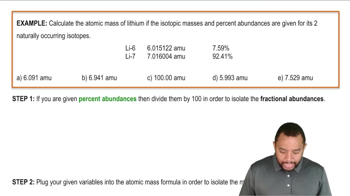Here are the essential concepts you must grasp in order to answer the question correctly.
Electron Affinity
Electron affinity is the amount of energy released when an electron is added to a neutral atom in the gas phase, forming a negative ion. A more negative electron affinity indicates a greater tendency for an atom to gain an electron, which is often associated with the stability of the resulting anion.
Recommended video:
Comparison of Atoms and Ions
When comparing the electron affinity of a neutral atom like bromine (Br) to that of its anion (Br⁻), it is essential to consider the electronic structure. The addition of an electron to Br results in Br⁻, which already has an extra electron, affecting its ability to attract another electron due to increased electron-electron repulsion.
Recommended video:
Atomic Mass Comparison Example
Trends in the Periodic Table
Electron affinity generally increases (becomes more negative) across a period from left to right and decreases down a group in the periodic table. Understanding these trends helps predict the behavior of elements like bromine, as its position in the periodic table influences its electron affinity compared to its anion.
Recommended video:
 McMurry 8th Edition
McMurry 8th Edition Ch.6 - Ionic Compounds: Periodic Trends and Bonding Theory
Ch.6 - Ionic Compounds: Periodic Trends and Bonding Theory Problem 69
Problem 69 Verified step by step guidance
Verified step by step guidance

